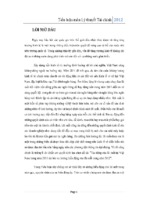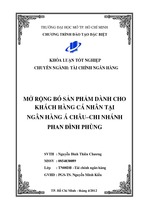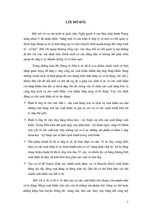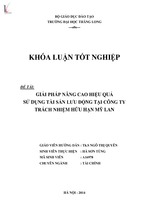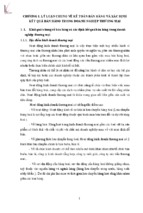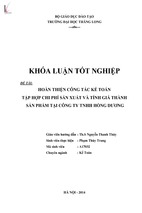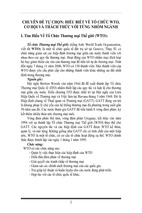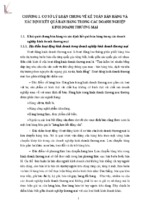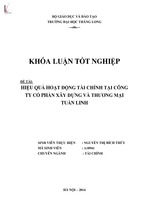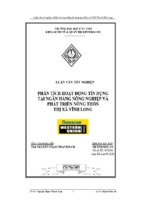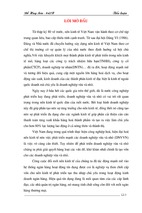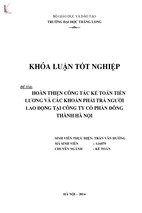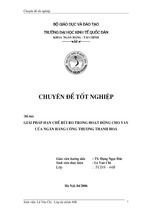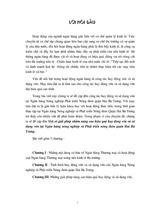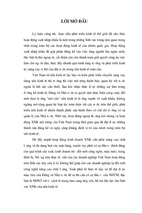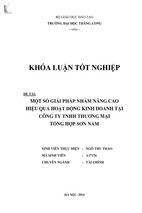FOREIGN TRADE UNIVERSITY
FACULTY OF BUSINESS ADMINISTRATION
---------***--------
GRADUATION THESIS
Major: International Business Administration
A STUDY ON WITHDRAWN MERGER PROPOSALS
INVOLVING PRIVATE TARGET
Student name
: Truong Huy Hoang
Student code
: 1111260037
Class
: Advanced Business Administration
Intake
: 50
Supervisor
: Assoc. Prof. Dr. Nguyen Thu Thuy
Hanoi, May 2015
TABLE OF CONTENTS
LIST OF ABBREVIATIONS....................................................................................
LIST OF FIGURES...................................................................................................
LIST OF TABLES.....................................................................................................
ACKNOWLEDGEMENTS......................................................................................
CHAPTER 1: INTRODUCTION..........................................................................1
1.1. Background........................................................................................................1
1.2. Research questions and research objectives......................................................3
1.3. Scope of the study..............................................................................................4
1.4. Research methodology.......................................................................................4
1.4.1. Method of collecting data............................................................................4
1.4.2. Method of processing data..........................................................................5
1.5. Thesis structure..................................................................................................5
CHAPTER 2: LITERATURE REVIEW...............................................................7
2.1. Merger and withdrawals of merger....................................................................7
2.2. Empirical evidences of related literature about withdrawals of merger...........8
2.3. Factors affecting withdrawn merger proposals’ abnormal return.....................9
2.3.1. Target firm status.........................................................................................9
2.3.2. Method of payment....................................................................................10
2.3.3. Bidder cash level........................................................................................11
2.3.4. Bidder leverage level.................................................................................11
2.3.5. Abnormal return from merger announcement...........................................11
2.3.6. Multiple bidders.........................................................................................12
2.3.7. Relatedness................................................................................................12
2.3.8. Relative size of bidder versus target.........................................................13
2.3.9. Financial crisis..........................................................................................13
2.3.10. Bidder’s return on assets.........................................................................13
CHAPTER 3: RESEARCH DESIGN..................................................................14
3.1. Estimation of valuation effects........................................................................14
3.2. Multivariate analysis........................................................................................15
3.2.1. Hypotheses.................................................................................................15
3.2.2. Models........................................................................................................16
3.3. Data and samples.............................................................................................20
3.4. Sample description...........................................................................................21
3.5. Correlation matrix............................................................................................23
CHAPTER 4: EMPIRICAL RESULTS AND FINDINGS.................................26
4.1. Overview of Australian economy....................................................................26
4.2. Results from estimation of valuation effects...................................................29
4.2.1. Not control for method of payment...........................................................29
4.2.2. Control for method of payment.................................................................32
4.3. Results of multivariate analysis.......................................................................34
4.4. Robustness checks...........................................................................................45
4.4.1. Robustness check with event window (-1,+1)...........................................45
4.4.2. Robustness check with event window (-2,+1)...........................................54
CHAPTER 5: CONCLUSIONS, RECOMMENDATIONS, AND
LIMITATIONS......................................................................................................64
5.1. Conclusions......................................................................................................64
5.2. Recommendations............................................................................................65
5.3. Limitations and suggestions for further study.................................................67
REFERENCES......................................................................................................69
APPENDIX............................................................................................................72
LIST OF ABBREVIATIONS
ANNCAR
BIDDERCASH
BIDDERDEBT
FINCRISIS
FDI
GPD
MULTIBID
PRIV
PRIVSTOCK
Announced cumulative abnormal return
Bidder's cash level
Bidder's cash level
Financial crisis
Foreign direct investment
Gross domestic product
Multiple bidders
Private target
Private target and the intended method of payment for the
RELATED
RESIZE
ROA
VIF
WITHCAR
merger is stock
Bidder and target are in related industries
Relative size of bidder over target
Return on assets
Variance inflation factor
Withdrawn cumulative abnormal return
LIST OF FIGURES
Figure 4.1: Gross domestic product of Australia (in US Dollar)...............................26
Figure 4.2: GDP growth rate of Australia (in percentage).........................................27
Figure 4.3: GDP per capita of Australia (in US Dollar)............................................27
Figure 4.4: World inflation rate versus Australia inflation rate (in percentage).......28
Figure 4.5: Key foreign investment in Australia by region/areas of origin..............28
LIST OF TABLES
Table 3.1: Statistical descriptions of variables using in models................................22
Table 3.2: Correlation matrix for variables with event window (0, +1)....................23
Table 3.3: Results of multicollinearity test for sample event window (0,+1)...........25
Table 4.1: Mean cumulative abnormal returns of proposal announcements.............29
Table 4.2: Mean cumulative abnormal returns of proposal withdrawals..................30
Table 4.3: MHW test for withdrawn abnormal return with event window (0,+1)....31
Table 4.4: Non-parametric T-test for withdrawn abnormal return with event window
(0,+1).......................................................................................................................32
Table 4.5: Bidder’s valuation effects based upon target public status and................33
Table 4.6: Multivariate analysis result of model 1.....................................................35
Table 4.7: Multivariate analysis result of model 2.....................................................36
Table 4.8: Multivariate analysis result of model 3.....................................................37
Table 4.9: Multivariate analysis result of model 4.....................................................38
Table 4.10: Multivariate analysis result of model 5...................................................39
Table 4.11: Multivariate analysis result of model 6...................................................40
Table 4.12: Summary of multivariate analysis results of six models for event
window (0,+1)............................................................................................................41
Table 4.13: Multivariate analysis result of model 1...................................................46
Table 4.14: Multivariate analysis result of model 2...................................................47
Table 4.15: Multivariate analysis result of model 3...................................................48
Table 4.16: Multivariate analysis result of model 4...................................................49
Table 4.17: Multivariate analysis result of model 5...................................................50
Table 4.18: Multivariate analysis result of model 6...................................................51
Table 4.19: Summary of multivariate analysis results of six models for event
window (-1,+1)........................................................................................................52
Table 4.20: Multivariate analysis result of model 1...................................................55
Table 4.21: Multivariate analysis result of model 2...................................................56
Table 4.22: Multivariate analysis result of model 3...................................................57
Table 4.23: Multivariate analysis result of model 4...................................................58
Table 4.24: Multivariate analysis result of model 5...................................................59
Table 4.25: Multivariate analysis result of model 6...................................................60
Table 4.26: Summary of multivariate analysis results of six models for event
window (-2,+1)........................................................................................................61
ACKNOWLEDGEMENTS
I cannot express enough thanks to my thesis supervisor – Associate Prof., Dr.
Nguyen Thu Thuy – for her continued support and encouragement. A complicated
quantitative study like this thesis is really a huge challenge in which I have to admit
that sometimes I felt lost and demotivated. However, with just a few short talks,
Mrs. Thuy could clearly guide me the strategy to complete the thesis, helped me on
how to tackle problems, and really inspired me to strive for my best for the study. I
was also surprised by her professionalism and enthusiasm while I submitted my
thesis draft in the evening and could receive so detailed and essential comments for
my thesis in just the morning next day. It is my luck to have an opportunity to work
with her, in which I can not only complete a good thesis but also learn much from
her professionalism and her research skill.
I also would like to express my most sincere gratitude to Dr. Cao Dinh Kien, for all
his support and advices. If it would not be Dr. Kien, I could not approach a wide
range of highly quality papers and database, and find the idea for this thesis. In
addition, thanks to the great knowledge and skills of Dr. Kien about running
qualitative models, I can have lots of advices which are crucial for my thesis.
I am also indebted my friends with all their helps in this work. For Nguyen Viet
Duong, I would like to thank him very much for his sharing about the experience in
doing thesis and for guiding and reminding me the basics about statistics and
econometrics. For Hoang Ngoc Anh and Nguyen Duc Hung, thanks to their help, I
can access to the database of California State University Fullerton and of La Trobe
University, which are the critical condition to complete my thesis.
And it does not come to this day by chance, but for all past four years, I owe special
thanks to my lecturers and friends at Foreign Trade University for everything they
have done for me. And foremost, to my family, words cannot express my
gratefulness. For this and more, this is my gift to them.
Truong Huy Hoang
Hanoi, May 2015
1
CHAPTER 1: INTRODUCTION
1.1. Background
The phenomenon of mergers and acquisitions has developed to become a highly
popular form of corporate development to create growth and diversity (Cartwright
and Schoenberg, 2006). Merger and acquisition are a vital part of both healthy and
weak economies and are often the primary way in which companies are able to
provide returns to their investors, stakeholders, and owners (Sherman, 2010).
However, in general, out of ten proposals for a merger in Australian Stock
Exchange, one of them will be withdrawn. In the world as a whole, proposals that
are withdrawn constitute a ratio of one over twenty (summarized from Thomson
Financial SDC Platinum™ database). Because of its large proportion in the
population of total merger proposals, the withdrawn merger proposals should
account for an important part of academic research in merger and acquisition field
and also in real life business practices. A withdrawn proposal is intriguing as it can
reverse previous effects caused by the results from the announcement of the
proposal. By how much important the effects of an announcement to firm valuation,
we would expect that much important the effects of a withdrawn proposal for
investors in the valuation of firm value. But the sad fact is that many researchers
have been focusing on examining the effects of the announcement of a proposal but
not many of them pay proper attention on effects of withdrawn merger proposal.
In consideration of a research in merger and acquisition field, it is widely known
that effects of an announcement of a proposal from a public bidder can vary by
many characteristics, such as those of bidders, targets, market, and from the
proposal itself. Therefore, it would be expected that the signal resulting from a
withdrawn proposal would also be affected by that many attributes. A withdrawn
merger proposal requires more thorough and more attentive dedication in examining
what influences its variations.
In particular, there is an important research aspect, in which we try to examine the
valuation of a bidder in response to a merger bid may be conditioned on whether its
corresponding target is a privately-held or is a publicly-traded company. Effect
2
causing by whether the target is public or private company, which I call it as target
status, in firm valuation is expected to be significant as private and public targets
are inherently different because of information asymmetry, and in general, acquirers
will have different ownership implications for takeover strategy for private targets
versus for public targets. In other word, the signal relayed from the withdrawal of
merger bids for private targets may be unique in comparison with those of their
public counterparts. Previous studies generally ignored merger proposals involving
private targets or did not put proper attention to this unique characteristic. Given the
implications might have in firm valuation, this thesis contributes an effort to
illuminate whether the characteristic of a firm status affects firm value.
Researching on the effect of firm status on merger deal abnormal return is important
for both academics and business practitioners. For academic researchers, this
studies dig into a new corner of merger and acquisition field, which is withdrawals
involving private targets, in which helps to enrich the theoretical framework and
might offer opportunity for further exploration. One aspect of information
asymmetry, which represents by whether the firm status is public or private, is
further examined through the effect of withdrawn merger proposals. In addition, the
effects of other characteristics previously pointed out by other researchers that
affect firm valuation in a deal are now more strengthened with evidences from this
study. In practical business life, the implications from this study can provide
insights and useful knowledge for investors and merger consultants. Investors can
have a better approach in understanding how valuation of a public firm is different
from a private one in a deal. Based on this, they can offer fair price between target
and bidder, which is one of the crucial factors contributing to the success of a deal.
Additionally, understanding of impact of other characteristics about the deal, such
as the method of payment and effect of financial crisis, is also useful in the process
of making a successful deal.
In addition, an important noticeable point here is that not many researches on the
topic of withdrawals of mergers involving private targets have been done in Asia
countries context but there are only very few of them have been done for the United
States. In other words, as there are significant differences among above countries’
3
business environments, there is a doubt that whether existing theories are valid to
explain the effect of firm status, in which a firm is a public or private company, on a
withdrawn merger proposal. Realizing the lack of empirical evidences in Asia
context, the objective of this study is to examine how firm status and other control
variables impact firm valuation from withdrawn merger proposals for selected listed
companies in Australian Stock Exchange. If the empirical evidence supports the
general literature for Australia case, we would further examine this effect for other
countries in Southeast Asia and East Asia, and aim to conclude a universal
implication for Asia countries context. Due to the lack of time and data, this thesis
first aims only Australian context but opens for further researches in different
contexts in the future.
This thesis, which is named “A study on withdrawn merger proposals involving
private target”, contributes to literature by assessing the signal relayed by
withdrawn mergers involving private targets. By using event study on estimating
valuation effects and by using ordinary least square regression models to check
correlation between variables, this thesis examines empirical evidence to support
hypotheses, generate implications, and contribute to strengthen the theoretical
framework in merger and acquisition field. The findings in this thesis demonstrate
that announcement of withdrawals of merger proposals involving private targets
produce negative and significant valuation effects on the bidders’ stock on average.
This result is opposite to what has been found for withdrawals of mergers involving
public targets, and verifies that the signal relayed for withdrawals of private targets
is unique. Even when controlling for the method of payment, it is proved that this
result remains constant.
1.2. Research questions and research objectives
Under the scope of this study, this thesis aims to answer two research questions.
Firstly, “In Australian Stock Exchange, do withdrawals of mergers involving private
targets have unique response in comparison with those involving public targets?”
Secondly, “Is the above effect independent with the method of payment?”
4
Besides research questions formulation, clearly definition of research objectives is
essential before conducting a study, especially quantitative research. Formal
quantitative research should not begin until the objectives have been clearly
defined. Clear objectives aim to explain the purpose of the research in measurable
terms and define standards of what the research should accomplish (Zikmund,
1997). In order to achieve its purposes, this study has the following objectives:
Estimate and compare valuation effects of withdrawn mergers which is
control for firm status (public versus private);
Examine whether the above effect is dependent on the method of payment or
not (stock payment only versus cash);
Analyze the estimation effect by multivariate analysis with two key variables
which are firm ownership (public or private) and method of payment, and
other proper control variables based on literature and previous researches;
Make recommendations and offer suggestions for further researches.
1.3. Scope of the study
The object of this research is studying about withdrawn merger proposals in
Australian Stock Exchange, in which the acquirer is a publically traded company,
and the target is either private or public company, not including other types of
company such as subsidiaries, joint ventures, and government-owned. The scope of
time is for the period of ten years, from 2002 to 2013. Given the data available, 68
observations are qualified for the scope of this study.
1.4. Research methodology
1.4.1. Method of collecting data
Observations of withdrawn merger proposals are obtained from the Thomson
Financial SDC Platinum™ database. Criteria of qualified observations under the
scope of this study are (1) the acquirers are listed in Australian Stock Exchange, (2)
the announced merger proposals were withdrawn, and (3) announcement date and
withdrawn date are from 2003 to 2012. The stock prices are obtained from
Morningstar® DatAnalysis Premium Database. The market benchmark index is
5
available in Yahoo Finance. Data collection process will be introduced in more
detail in the later section.
1.4.2. Method of processing data
There are two key methods of processing data in this thesis. The first one is the
estimation of valuation effects. For this approach, I use event study to calculate
abnormal return to estimate valuation effects after the announcement of the
withdrawals. Then I compare two sub-samples, one is for private targets, and the
other is for public targets, to see if there are any differences in the valuation effects
of the two sub-samples. The second approach is using descriptive statistics,
correlation, and multiple regression models to run multivariate analysis among key
and control variables. Then I will analyze the correlation and coefficient of
variables to generate proper implications.
1.5. Thesis structure
This thesis has five chapters. A brief introduction of purpose of each chapter is
addressed below:
Chapter 1: Introduction
This chapter presents research context of the research topic, the importance of this
research, research problems, research objectives, research methodology, and
research scope.
Chapter 2: Literature review
This chapter reviews relevant literature and researches have been conducted before
to establish theoretical framework for this thesis.
Chapter 3: Research design
This chapter presents the research designs with two approaches in more detail,
which are the estimation of valuation effects and the multivariate analysis. This
section also introduces data collection method in more detail and provides a
comprehensive description of data used in this study.
Chapter 4: Empirical results and findings
6
In this chapter, by using both estimation of valuation effects and multivariate
analysis, I would like to explore the features of explanatory variables and the
relationship among variables in six different models. Furthermore, this chapter also
introduces robustness check section to ensure that our findings are consistent over
different measures.
Chapter 5: Conclusions, recommendations, and limitations
This final chapter presents main conclusion as a summary of previous results and
findings. It also introduces some recommendations, limitations of this study, and
suggestions for researches in the future.
7
CHAPTER 2: LITERATURE REVIEW
2.1. Merger and withdrawals of merger
A merger is a transaction in which one corporation (the bidder) secures title to the
outstanding shares or assets of another (the target) (Dodd, 1980). Gaughan (2011)
defines mergers as “a combination of two corporations in which only the one
corporation survives and the merged corporation goes out of existence”.
Researchers are also familiar with the definition of Sherman (2010), who defines a
merger as “a combination of two or more companies in which the assets and
liabilities of the selling firm(s) are absorbed by the buying firm. Although the
buying firm may be a different organization after the merger, it retains its original
identity”.
Mergers can be classified into three different categories: the vertical integration
mergers; the horizontal mergers; and the diversification merger. The first type,
vertical mergers are combinations of companies that are symbiotically related. As
stated by Scott (2003) and Gaughan (2011), these mergers happen when
organizations are engaged in related functions but at different stages in the
production process.
Horizontal mergers, the second type, occur when acquirers and targets performing
similar functions and they want to merge to increase the scale of their operations. It
occurs, for example, when two competitors combine, and economies of scale are
realized (Scott, 2003; Gaughan, 2011).
The third type, diversification, happens when one company acquire one or more
other companies that are neither trading/operating partners nor have the same
business lines, but rather operating in different unrelated industries. The extreme
form of diversification is the conglomerate (Scott, 2003).
The academic study of mergers involves a wide interdisciplinary field of research.
Mergers are ever present in the corporate world, and which become an increasingly
important part of corporate strategies. However, not every attempt to undertake a
8
merger between two firms is completed; the failure rate in mergers and acquisitions
that is reported is actually high (Refsnes, 2012).
With regard to withdrawals of merger, there is currently no official definition for
that term till now in the academic research; however, one can understand a
withdrawal of merger as the bidders, both voluntarily and involuntarily, terminate
their offer to purchase the target. There are many reasons that lead to the
withdrawals of merger. According to Sherman (2010), some of the reasons
attributed for termination of a merger include a lack of adequate planning, an overly
aggressive timetable to closing the deal, management hubris, management
inexperience in merger deal negotiation, or simply too intensive competition from
other bidders. A transaction as complex as a merger or an acquisition has many
potential problems and pitfalls; therefore, it is easy to understand that good
planning, proper time for negotiation, and management experience in a merging
deal are critical factors to lead a deal to success.
2.2. Empirical evidences of related literature about withdrawals of merger
Empirical evidences on topic of withdrawals of mergers are mainly in US context.
In his research, Dodd (1980) finds that regardless of whether the proposal is
successful or cancelled, stockholders of target firms earn positive abnormal returns
from the announcement of merger proposals. For merger proposals that are
eventually cancelled, on average, stockholders of target firms earn significant
negative abnormal returns on the date of the announcement of the termination of
negotiations. As for the side of stockholders of bidder firms, in both successful and
withdrawn merger proposals, there is evidence of negative abnormal returns for
bidders over the duration of the proposals.
Asquith (1983) and Bradley et al. (1983) examine abnormal stock returns
throughout the entire merger process for both successful and unsuccessful merger
proposals. They point out that increases in the probability of a successful merger bid
benefit the stockholders of target firms, and that increases in the probability of
merger withdrawal negatively affects both target and bidder’s stockholders. There is
also evidence that the stock market forecasts probable merger targets in advance of
9
the merger announcement, therefore, previous studies have underestimated the
market’s reaction to merger bids.
With regard to method of payment, Chang and Suk (1988) find that on average, in
US context, acquirers that offer common stock experience a positive abnormal
return. On the contrary, this observation is not clearly seen when firms offering
cash. In other world, the withdrawals of merger transactions that were financed with
stock result in positive and significant valuation effects for bidders. The results are
not significant when cash or mixed financing was planned.
However, there are conflicts in this issue in current literature. Sullivan et al. (1994)
find that the valuation effect of the acquirer is insignificant, regardless of whether
the intended method of payment was stock or cash. Davidson et al. (1989) find that
the valuation effect of the acquirer is negative and significant at the time of the
withdrawal.
This thesis focuses on the topic of withdrawn mergers of privately-held targets, and
in Australian context, which are two aspects that were not put much consideration in
previous studies. The unique ownership characteristic of the private target allows
for a special interaction with the bidder, which should relay unique valuation effects
for the bidders when proposed mergers with these targets are withdrawn.
In the next section, I would like to introduce in more detail about the literature and
previous findings with regard to factors that may have influence in the variation of
withdrawn abnormal returns. The following theoretical framework is the foundation
to establish proper models in the multivariate analysis section.
2.3. Factors affecting withdrawn merger proposals’ abnormal return
2.3.1. Target firm status
Target firm status decides whether target is a publicly-traded or privately-held
company. In consideration of a merger, target firm status has significant impact on
bidder returns. Target firm status has distinctively different implications on bidder
returns because of the following reasons. First, as suggested by Fuller et al. (2002),
private targets are likely to be sold at a discount in comparison with public targets to
10
compensate for their lack of liquidity. Private targets do not enjoy the benefits of
publicly-trading as public targets; therefore, the ownership of a private target is not
easily transferable as public one is. The lack of liquidity helps bidder to purchase
the target firm at a lower price to remove the disadvantage of liquidity deficiency
once the target is under ownership of the bidder.
Second, private targets are also different from public targets because they are not
required to disclose public information. This makes the targets less attractive as
their financial information and their intention for a merger is not available, hence,
they might be ignored by many prospective bidders. Even when a bidder makes the
effort to pursue a private target, there is substantial information asymmetry which
would make the valuation of target firm become harder, leading to the demand of a
discount for bidder price (Officer et al., 2009).
Combining the above two factors, bidders for private target can demand a
discounted price for the deal; therefore, the mergers involving private targets would
have positive returns for bidders in comparison with those involving public
counterparts. The withdrawal of the mergers involving private targets may eliminate
the potential benefits might be generated and therefore affects negatively on bidder
withdrawal abnormal return.
2.3.2. Method of payment
The interpretation of a withdrawn merger bid is different when involving private
targets. For merger transactions that were financed with stock, Madura and Ngo
(2012) state that the use of stock to acquire a private target relays a favorable signal.
Consequently the termination of that merger may eliminate that favorable signal and
result in the negative withdrawn abnormal return. This contends that the method of
payment signals the intrinsic value of bidders to the market, because the bidder with
the intrinsic value information may choose the payment method benefiting the
bidders. This hypothesis was indirectly supported by Jensen and Meckling (1976)
and Myer and Majluf (1984).
In summary, the withdrawal of a merger proposal involving a private target that was
to be financed with stock removes the implicit endorsement of the bidder by the
11
private target. It also eliminates the monitoring benefits that would have occurred
from creating a new block-holder, which is the private target owner (Madura and
Ngo, 2012).
2.3.3. Bidder cash level
Bidder cash level should have significant impacts on firm merger decision. Cash
situation of bidders influences bidders’ decision on which to use cash or stock as
payment or medium, as supported by Martin (1996) and Harford (1999). Therefore,
we might expect bidder cash level also affect market interpretation of withdrawn
merger decision. When the cash level is already low, a decision of a withdrawn
merger might be more acceptable and does not impact bidder stock return. In
contrast, if the withdrawal of merger involving private target cannot be attributed to
affordability, it may signal a negative response in bidder stock price.
2.3.4. Bidder leverage level
A merger can significantly impact the borrowing capacity of the bidder because it
demands the bidder to raise significant funds to purchase the target (Galai and
Masulis, 1976; Travlos, 1987). A withdrawn merger of a private target may be more
acceptable to the market if the bidder’s financial leverage is already high.
Conversely, if the bidder leverage level is not so high, the market would be unlikely
to attribute the withdrawals of the merger for the reason of financial leverage
burden. Therefore, the withdrawn merger of a private target may relay a more
pronounced negative signal on the bidders’ returns.
2.3.5. Abnormal return from merger announcement
The announcement of a merger proposal and the announcement of the withdrawal
of that proposal are two highly correlated opposite events. We would expect the
withdrawal of the proposal will reverse any abnormal gain or loss for bidder which
previously caused by the announcement of that proposal (Madura and Ngo, 2012).
If the bidder enjoys positive abnormal return when announces the merger proposal,
the bidder would suffer negative returns when that proposal is announced to be
withdrawn. And vice versa, if the bidder suffers a loss for the announcement of the
proposal, it would have a positive return when that proposal is withdrawn.
- Xem thêm -

